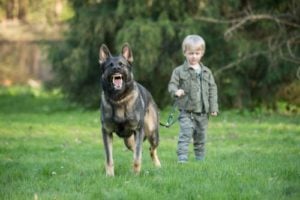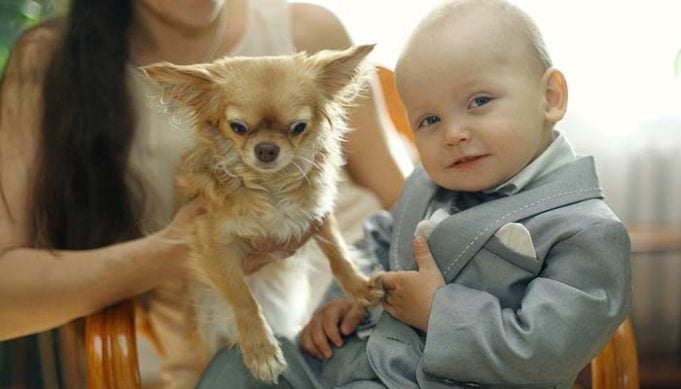Why don’t some dogs like children? I can reassure you right away, your dog doesn't have a hidden agenda to hate on kids. Aside from many, every day causes for this phenomenon, certain genetic predispositions can be established and used to help us understand the problem.
It's vital for dog owners and dog lovers to understand that canines are still animals, even if they have been domesticated and trained. Instincts continue to be strong within dogs, and cannot always be managed. Studies upon studies have demonstrated, and animal behavior experts warned, that dogs can be a danger to kids and this must be taken much more seriously, but few pet owners actually pay attention.
We must also take a look at how dogs actually perceive children.
On one side there is an unwavering friendship that can unite a child and a dog, and on the other, we see examples of cases of aggression towards children from their own, family dogs. This is what made dogs the 2nd most dangerous animal in the United States.
So what causes this contradiction between dogs loving some kids yet being aggressive towards other children? There are several reasons for this.
ALSO READ: Kids vs Dogs – Differences and Similarities in Raising Them
The Dog May Perceive the Child as a Puppy
 This is a direct consequence of the genetic imprinting among dogs. First of all, it must be said that very few dogs like children in general. Almost all dogs love, defend and protect only the children of their family, whereas they can tolerate others with some difficulty. How tolerant the dog is towards stranger children will vary by breed.
This is a direct consequence of the genetic imprinting among dogs. First of all, it must be said that very few dogs like children in general. Almost all dogs love, defend and protect only the children of their family, whereas they can tolerate others with some difficulty. How tolerant the dog is towards stranger children will vary by breed.
But what's going on in nature, between a puppy and an adult dog?
Quite simply, this goes back to the hierarchy of packs – canines (and often adult males) respect, defend and protect only puppies in their pack. If a puppy that the dog encounters is an offspring of a dog from their pack, they will protect it. Few-months-old puppies don't have any defenses against an adult male. For this reason, the canine must be restricted by a powerful instinct not to attack the puppies of his pack.
However, these inhibitions are entirely irrelevant when it comes to puppies foreign to the pack. Since they can't be the offspring of anyone from the pack, one of the possible interpretations is that they are children of a potential “invader” who could threaten the territory and the pack.
A dramatic conclusion, but a perfectly logical one from the genetic point of view, is that the dominant male dog does not hesitate to attack them. In nature, this situation is not common because the territories are well defined. But this example serves to make it clear that the dog instinctively and naturally respects “his” puppies, but that he feels no obligation to love and respect the other children.
When we take into account the fact that dogs tend to associate children with puppies, there is a clear pattern here that explains part of the reason for dogs' animosity towards stranger children. In our current real world of dogs being around strangers – other animals, adults and kids – this can (and should) be fixed or at least managed with proper socialization of the dog so that he can tolerate anyone outside of his pack.
RELATED: 14 Safety Tips for Adopting a Dog When You Have Kids
Children Do Not Know the Rules of Canine Decency
 Not knowing the rules of canine decency can make children behave in a way that can upset even the most peaceful dogs. The typical example is to stare into the dog's eyes, which children often do since they are of a similar height. Unfortunately, for the child, this is a sign of respect and affection, while for some dogs (especially those less familiar with the kid) it may be a sign of challenge and an invitation to a fight.
Not knowing the rules of canine decency can make children behave in a way that can upset even the most peaceful dogs. The typical example is to stare into the dog's eyes, which children often do since they are of a similar height. Unfortunately, for the child, this is a sign of respect and affection, while for some dogs (especially those less familiar with the kid) it may be a sign of challenge and an invitation to a fight.
Whenever there is animosity between dogs and children, the owners usually place the blame on the dog regardless of the circumstances, and then they try to find a quick solution, without understanding the root of the problem. Context is always crucial in these situations, and a solution will be almost impossible to find unless you can determine the reason for the conflict.
A dog will not bite unless it is provoked. This is particularly true for a pet dog at home who's already socialized and trained. As a rule, any canine aggression towards anyone, including children, is preceded by a growl. You must interpret this growl as a warning. When it comes to kids, it's most often due to fear aggression.
The situation or the dog's environments may be a little too hectic or noisy. It's up to you to find out what's agitating it. Dogs do not speak as we do, that's why you have to know your companion to understand it well. Children don't always understand these boundaries.
What Triggers Aggression in Dogs?
Unfortunately, some dogs do not understand the behavior of children like screaming, stomping, sprinting through the house, playing, jumping, hitting things, etc. Your canine friend can misinterpret all these actions, and studies show that these are often the cause of why dogs are aggressive towards kids.
Dogs do not like to feel like their space is being invaded, just like some people do not tolerate children who tease them and pull their hair. As a consequence, our faithful companions tend to generalize behaviors, so they might associate these types of actions with all children, and they might start to dislike them as a whole.
The same can be said about kids – they do not often understand the boundaries of personal space, or what should and shouldn't be done to or around canines. For this reasons, it's absolutely crucial for dog owners to not only train their pets but also teach their kids how to behave around dogs and ensure that the dog “likes kids.”
VIDEO GUIDE: How to Teach Kids to Behave Around Dogs
5 Things You Can (And Should) Do
1. Inform Your Children
The first thing to do is to teach your kid about the kinds of behavior that can agitate a dog. It is essential for your child to be aware of the consequences that their actions can have. Teach them to take into account that dogs aren't people and that their cognition works differently.
In some families, it is quite rare to find children who are gentle, attentive and calm with their dogs. It is for this reason that parental education is required and this is also a part of the responsibility of the owner. Whatever the size and breed of your dog, you should always keep a close eye on both your pet and your child.
2. Set an Example
Treat your dog well in the presence of your child, provide it with its meals on time, don't yell at the dog or show any signs of aggression or punishment. Demonstrate how you respect the dog and his space. This will set an example for your kid and also help the dog associate positive feelings and proper treatment with a child. By doing so, your pet will think of children as being pleasant and caring.
3. Encourage Positive Behavior
Explain and teach your children how to exhibit positive behavior when dealing with a dog. Simple things like being calm, gentle and attentive. For a better relationship between your child and your dog, encourage them to play together in a manner that both might find interesting and stress-free. There are plenty of games for kids to play with their dogs.
4. Avoid Forcing the Dog to Socialize with Children
While socialization of your dog – getting him to meet strangers and unfamiliar children – is needed, don't force your dog to allow children to pet it, and dissuade your children from doing so, as this can be very dangerous if the dog is unwilling. Let the dog approach the child on its own terms without feeling pressured. This is the only way that will make the dog feel safe. Read more about this in the guide for introducing newborns to dogs.
5. Seek Help from an Expert
It is also possible that a dog has had a bad experience with children in the past, maybe even when they were a puppy. Dogs have a good memory in general, and they usually remember events for years. Furthermore, they can also associate a single bad experience they had with a child with all children in general.
This kind of problem will be more challenging to solve and will require dedication, patience and time spent with your dog until he becomes more comfortable around kids. In these cases, it is advisable to contact a canine behavior expert that will work with the dog to alleviate its anxieties.
 In this way, at least some cases of aggression will be avoided, but it might not be enough. Another essential component to take into account is the prey drive of the dog, which depends on the breed.
In this way, at least some cases of aggression will be avoided, but it might not be enough. Another essential component to take into account is the prey drive of the dog, which depends on the breed.
Unfortunately, this is a component that many parents are unaware of as it is at the root of almost every truly dramatic episode of dogs attacking children. For this reason, it may be better to adopt dogs that are best for kids and are less likely to have unhealthy relationships with them.
READ NEXT: The Ultimate Guide for Raising Kids with Dogs – 17 Things Every Parent Should Know














